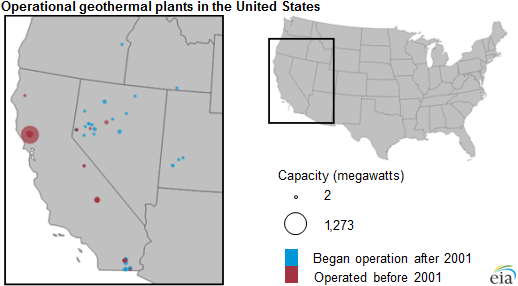Geothermal plants are virtually emissions free, and unlike renewable sources such as wind and solar, they provide an available, dispatchable source of baseload power that is able to operate at a relatively high capacity factor.
Geothermal resources used to produce renewable electricity in western states
Reprinted with permission from | Today in Energy
Geothermal energy has been a small, but consistent, source of electricity in the United States since 1971, providing 0.4% of total U.S. generation in 2013. California is the site of most U.S. geothermal capacity, but since 2001 new geothermal capacity additions have increasingly been located in other western states as most of the low-cost resources in California have already been developed.

Unlike conventional thermal power plants, which burn fuel (typically fossil fuels) to heat water and generate steam to drive turbines, electricity is generated from conventional geothermal resources by tapping underground reservoirs of hot water. The heat from the steam or hot water is then used to generate electricity in much the same way as in other steam turbine power generators. This process requires plants to be able to access high-temperature fluids from deep, naturally permeable rock formations. These resources are most commonly found in the western United States.
Unlike conventional geothermal resources, which take advantage of naturally permeable rock formations, enhanced geothermal systems (EGS) are engineered reservoirs created to produce energy from otherwise noneconomic geothermal resources. EGS plants fracture impermeable rock formations to access hot fluids needed to generate power. The high-pressure hydraulic fracturing inherent in many EGS projects has in the past caused seismic events that are large enough to be felt by the public, similar to induced seismicity caused by shale gas production. An EGS project in Basel, Switzerland, was cancelled in 2009 because of a number of induced seismic events. Such events are rare, however, and the U.S. Department of Energy has developed a protocol to deal with seismicity issues. EGS plants are currently being developed in several countries, and the first commercial-scale plant in the United States, the Desert Peak East pilot project in Nevada, began operating in 2013.
There are currently 64 operating conventional geothermal power plants in the United States, accounting for nearly 2,700 megawatts (MW) of total capacity at the end of 2013. Over three-fourths of U.S. geothermal power generation in 2013 was in California, largely because of favorable geothermal resources, policy, and market conditions in the state. The largest group of geothermal power plants in the world, a complex called the Geysers, located in Northern California, has more than 700 MW of capacity.
Since 2001, only 7 of 30 new plants exceeding 1 MW have been built in California, where most available low-cost geothermal resources have previously been developed. Sixteen of those 30 plants built after 2001 are in Nevada, with the remainder in Oregon, Idaho, Utah, and Hawaii. Most of the newer plants are relatively small, and while geothermal generation rose 11% between 2008 and 2013, the geothermal share of total U.S. electricity generation has remained consistently around 0.4% since 2001.

Note: Geothermal capacity factors represent conventional geothermal plants only. Data for 2013 are preliminary. PV is photovoltaic.
Geothermal plants are virtually emissions free, and unlike renewable sources such as wind and solar, they provide an available, dispatchable source of baseload power that is able to operate at a relatively high capacity factor. EIA projects that geothermal electricity generation could more than quadruple between 2012 and 2040 (increasing to over 67,000 GWh), helping California and other states with renewable portfolio standards satisfy their mandated renewable generation requirements.
About Today in Energy
Today in Energy! — topical, timely, short articles with energy news and information you can understand and use. Every business day we provide bite-sized pieces of information you can use in business, government, schools, and in your personal life. Our experts explain topical data, reports, issues, and trends to build your understanding of energy issues.
U.S. Energy Information Administration.
Principal contributor: Fred Mayes
The content & opinions in this article are the author’s and do not necessarily represent the views of AltEnergyMag
Comments (1)
Featured Product

